I mentioned previously that my default lunch during the cooler months of the year is a hot, steaming bowl of noodle soup (see our variations on quick noodle soups here). Similarly, during the warmer months of the year, I default to cold noodle salads. (Well, actually, I eat all of these interchangeably, not always corresponding to outside temperatures. :) Most of the time, what I end up making is a simple Vietnamese vermicelli bowl with whatever I happen to have in the fridge. I like to bulk the bowl up with vegetables, so that there’s at least as much lettuce as noodles, resulting in something that actually is more salad-like.
Lately, I’ve been trying to branch out a bit to try other kinds of noodle salads. From our recent travels to Japan, I wanted to try a cold soba dish. And living in Beijing has also introduced me to one of my favorite Beijing breakfasts, liang pi, or cold noodles (literally “cold skin”) originating from the province of Shaanxi.
Here I wanted to share recipes for these three noodle salads, in hopes that you might have a chance to try one of them before the summer is over. These are all flexible recipes, a springboard for whatever variations you can imagine. Because I usually make noodle salads as a quick lunch, I often don’t bother to add meat or protein unless I have leftovers in the fridge I can toss in. But I’ve made some suggestions below if you wanted to add it. The recipes for both the noodle bowls and the dressings below are for 2 servings, but I actually like to make a large batch of dressing and store it in a mason jar to use throughout the week, so if you intend to do that, please remember to increase the ingredient amounts accordingly. Lastly, I eat these salads more at room temperature, but if you prefer them actually cold, then chill the noodles in a tub of ice water before draining and putting into a bowl. The noodles taste best fresh and tend to harden if refrigerated (like cold rice). But the dressings can be chilled in the refrigerator prior to serving.
Vietnamese Vermicelli Salad Bowl (Bún)
Serves 2
To make this more of a salad, you’ll want to decrease the amount of noodles and increase the amount of vegetables listed. I also like to add some kind of fruit to my vermicelli bowl, for a bit of sweetness, so I’ve included that in the recipe below. Favorites include slices of fresh pineapple, strips of mango, or slices of starfruit. And, of course, you can also top your vermicelli bowl with grilled meat of any kind, like chargrilled pork, lemongrass beef, shrimp, or chicken. Crispy Vietnamese spring rolls also make a good topping. :) But, really, whatever leftovers you have in the fridge (rotisserie chicken perhaps?) will work. Whatever you do, make sure you don’t skip the fried shallots and crushed roasted peanuts on top for that extra bit of smoky flavor.
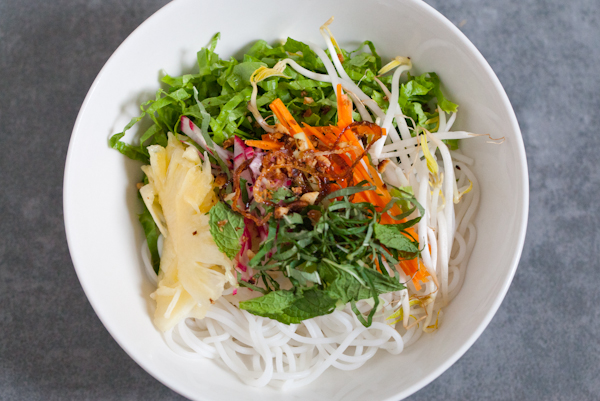
Noodle Bowl:
5 oz dried vermicelli noodles
2 large lettuce leaves
2-inch piece each of cucumber and carrot, julienned into thin strips
2 radishes, julienned into thin strips
handful Vietnamese herbs (such as mint, Vietnamese coriander, fish mint, etc.)
10 slices of pineapple, starfruit, or mango
handful beansprouts
2 tsp fried shallots (store-bought or homemade)
2 tsp crushed roasted peanuts
Fish Sauce Dressing (nuoc mam cham):
1 garlic
1 Thai bird chili
2 Tbsp raw cane sugar
2 Tbsp lime juice or vinegar
2 Tbsp fish sauce
1/2 cup water
1. Boil a pot of water and add the dried vermicelli noodles. Cook for about 5 minutes or until al dente. Drain and rinse the noodles under cold running water until the water runs clear and all the starch has been washed away. Drain well.
2. To make the dressing, pound garlic, chili, and sugar into a paste with a mortar and pestle (the sugar helps create friction as you pound). You could also just mince the garlic and chili with a knife, but I recommend pounding to release all the juices and flavor. Add lime juice or vinegar, and scrape the sides of the mortar to release the paste. Pour all this into a jar, and add fish sauce and water. This will keep in the fridge for about a week. If you want the sauce to keep longer (up to a month), omit the garlic, chili, and lime juice, and add them just before use.
3. Line the bottom of two bowls with the shredded lettuce. Add the noodles. (If the noodles have started clumping together, you can loosen them in a bowl of cold water, then drain well.) Then top the noodles with the cucumber, carrot, radish, fruit, beansprouts, and herbs. Lastly, sprinkle fried shallots and crushed roasted peanuts on top.
4. Â Serve the noodles with the sauce on the side. To eat, drizzle sauce over the bowl and toss lightly.
Japanese Chilled Buckwheat Noodles (Soba)
Adapted from Elizabeth Andoh’s Washoku and Takashi Yagihashi’s Takashi’s Noodles
Serves 2
Individual serving-size katsuobushi flakes are really convenient for this recipe. As a shortcut, you can use store-bought ponzu sauce as the dressing here, but if you have time, I do recommend the homemade ponzu below from Washoku, which is like dashi with soy sauce, sugar, and citrus juice (if you already have dashi on hand, then simply add the soy sauce, sugar, and citrus juice to a jar and shake). For added protein, try a raw quail’s egg (or raw egg yolk), which was part of the original recipe from Takashi’s Noodles.
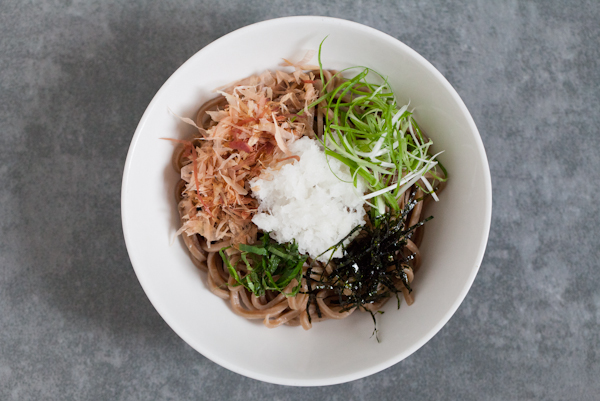
Noodle Bowl:
6 oz soba (buckwheat noodles)
3-inch piece daikon, peeled and grated to yield about 1/2 cup
1 scallion, cut into 2-inch pieces and thinly sliced lengthwise
2 small (snack-size) sheets of roasted nori, cut into thin slivers with scissors
1 (0.1 oz) individual packet katsuobushi flakes
2 shiso leaves, cut into thin ribbons (chiffonade)
Dressing:
2 Tbsp soy sauce
1 tsp sugar
1/4 cup water
2 square inches kombu
1 (0.1 oz) individual packet katsuobushi flakes
2 Tbsp fresh lemon, lime, or grapefruit juice
1/4 tsp grated lemon zest (optional)
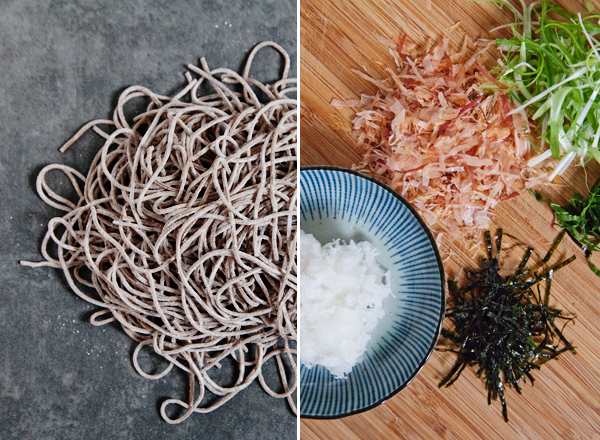
1. Boil a pot of water and add the soba noodles according to the package directions. (If using fresh noodles, cook for about 1 minute. If using dried, cook for 4-5 minutes. In both cases, you want it just al dente.) Rinse the noodles under cold running water until the water runs clear and all the starch has been washed away. Drain well.
2. Divide the noodles among 2 bowls. On top of the noodles, add small mounds of the grated daikon, sliced scallions, shredded nori, and katsuobushi flakes.
3. To make the dressing, combine the soy sauce, sugar, water, and kombu in a small saucepan and bring to a simmer. Remove from heat and add the katsuobushi flakes. Cover the saucepan, and let it stand or 2 minutes. Strain through a fine-meshed sieve into a jar. Add the citrus juice and (if using) lemon zest. Sauce will keep in refrigerator for 1 month.
4. Serve the noodles with the sauce on the side. To eat, drizzle sauce over the bowl and toss lightly.
Shaanxi Sesame Cold Noodles (Liang Pi)
Serves 2
There are different versions of this dish, and this recipe is based off the version I get from a local street vendor just down the street from where I live. (In the interest of full disclosure, I should mention that I got the noodles and wheat gluten from the vendor for the purposes of recreating this here — it was just a lot easier than tracking the ingredients down around town!) There are also different versions of the liang pi noodles themselves, but I find that the versions I eat in Beijing are quite similar to Cantonese ho fun, so that is what I suggest using in this recipe (ho fun is also what our family uses to make Vietnamese banh uot, which I find to be very similar to liang pi!). To make this more salad-like, decrease the amount of noodles and increase the amount of cucumber listed here. That’s actually how our street vendor serves this dish, with equal parts cucumber and noodles.
This dish traditionally involves a baked spongey wheat gluten known as kao fu or bran puff. It is similar in texture to tofu that has been frozen and then defrosted, which takes on a spongey consistency. Fried tofu puffs are also similar, but fried tofu probably doesn’t taste very good cold. Wheat gluten may be sold along with tofu at Asian grocery stores, but if you can’t find it you can substitute frozen-then-defrosted regular tofu or a medium-firm regular tofu.

Noodle Bowl:
12oz fresh wide rice noodles (ho fun – you can these precut as noodles or in sheets you can cut yourself)
7 oz spongey wheat gluten or tofu, cut into bite-size cubes
1/2 English cucumber
1/4 cup bean sprouts
2 Tbsp cilantro leaves
Sesame Dressing:
2 Tbsp sesame paste (or Tahini)
4 Tbsp Chinese black vinegar
2 Tbsp soy sauce
2 tsp sesame oil
2 cloves garlic, minced
dried chili flakes and chili oil, optional

1. Peel the rice noodles (or if you bought rice noodle sheets, cut them into wide noodle strips, then peel). Divide the peeled noodles among two bowls, sprinkle a bit of water over the noodles, and microwave each bowl for about 1 minute or until the noodles are soft and a bit translucent. (You can also steam the rice noodles in a wok or a bamboo steamer if you wish.) Let noodles cool.
2. To make the sesame dressing, combine all the dressing ingredients in a bowl and stir. [Update: Depending on how dense your sesame paste is, if the sauce ends up too thick you can thin it out with a bit of water.]
3. Top each bowl of noodles with the wheat gluten or tofu, julienned cucumber, bean sprouts, and cilantro leaves.
4. Serve the noodles with the sauce on the side. To eat, drizzle sauce over the noodles and toss lightly.

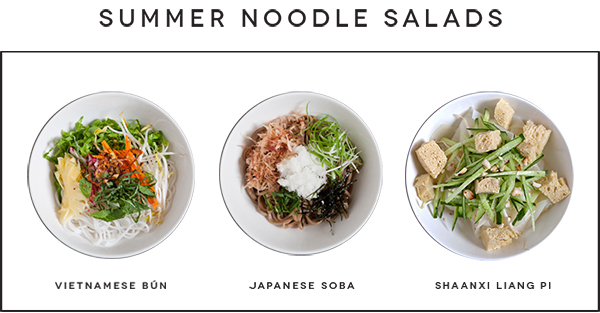

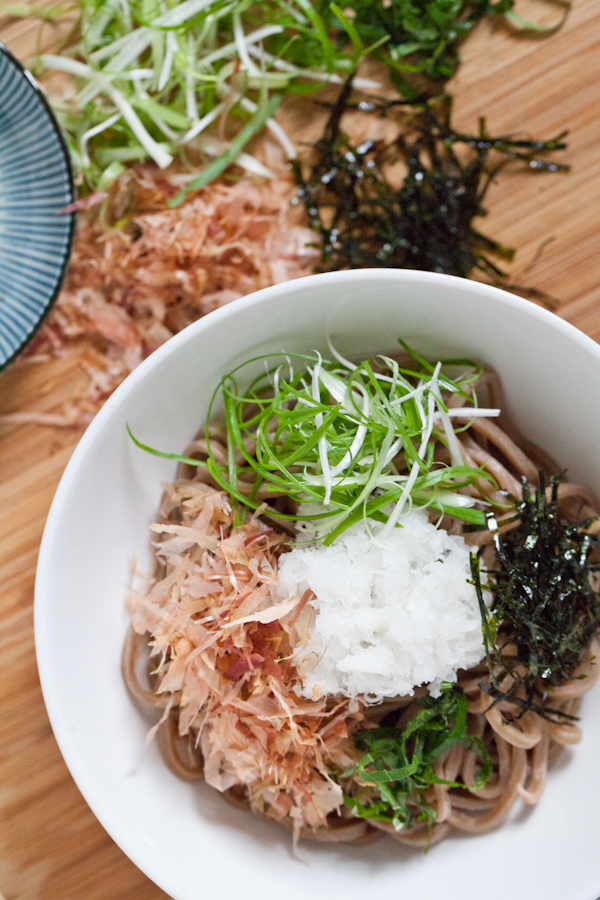
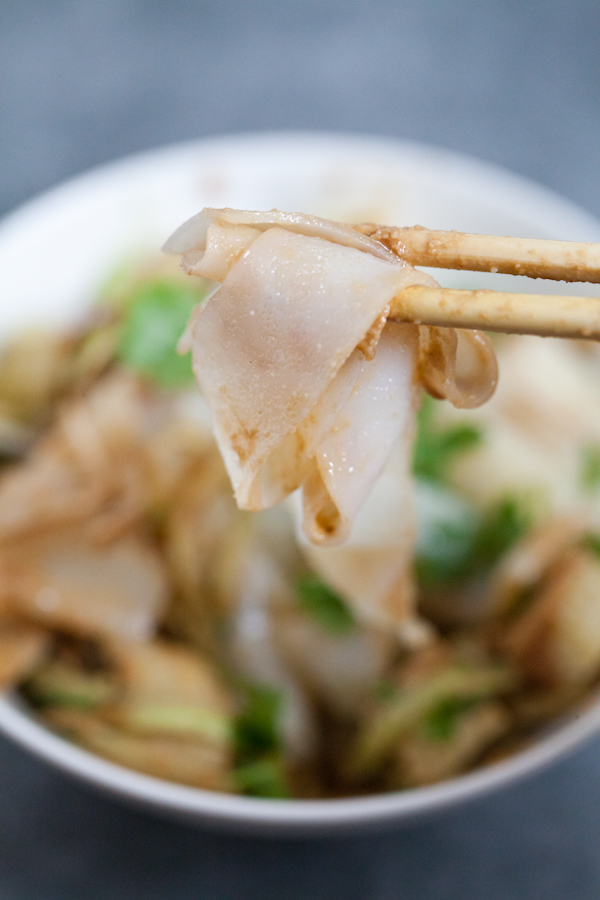
























Connect with us